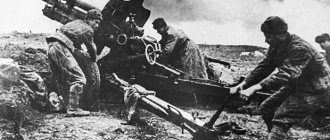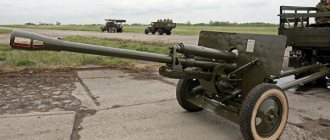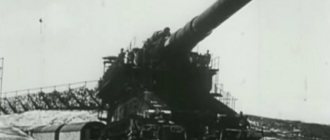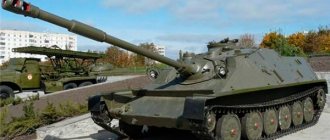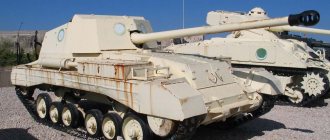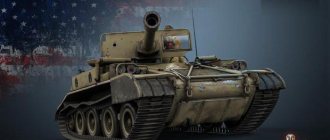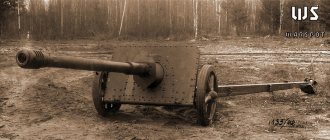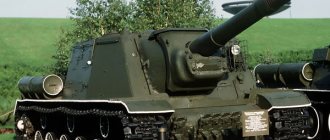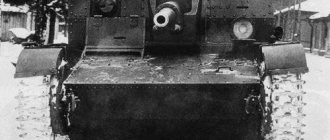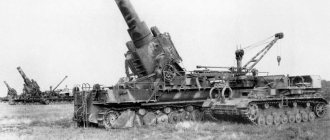The top 10 largest guns in the world are the largest guns of new and recent times. The huge calibers and destructive power of these monsters are truly amazing.
So, what are the biggest guns in the world in the top 10? Let's start with the smallest calibers. They, however, exceed this indicator for the vast majority of guns in service with modern armies of the world
.
By the way, the development of large-caliber artillery occurred during an era of active changes in the very philosophy of functioning and supporting the armed forces in all major powers. canned meat began to be supplied en masse to the troops and navy in the mid-second half of the 19th century.
.
Today it is
quite easy
to buy stewed meat And then the arrival of canned meat in the regular army meant nothing less than an increase in the mobility of the armed forces. After all, recipes with stew
reduced the time for cooking, and ready-to-eat meat in army-quality canned meat is still adored by millions of people today.
Rodman gun and Perm Tsar Cannon
It belonged to the category of Columbia guns and was released in 1863. Outwardly it looks like an elongated flask. Cast from cast iron. It was loaded from the muzzle (front). Weighing 22.6 tons, the caliber was 381 millimeters. The appearance of such massive guns was associated with the advent of the era of armored trains and armored ships.
It appears that American designs and technology were adopted by Russian gunsmiths. The 508mm cast iron gun was manufactured and tested in 1869. It was called the Perm Tsar Cannon. It fired charges from 50 to 120 kilograms at a distance of 1.2 kilometers.
It is noteworthy that the Russian model was already on its way to its installation site in St. Petersburg when it was returned to Perm. The thing is that by that time engineer Pavel Obukhov had developed a method for producing high-strength cannon steel. This significantly lightened the weight of the weapons. Moreover, the Obukhov plant began to produce large-caliber weapons, which began to be loaded from the breech (rear) part. Thus, the Perm Tsar Cannon instantly became obsolete and, at the direction of Emperor Alexander II, was preserved as an exhibit. Today it can be seen on the territory of the Motovilikha Plants Museum in Perm.
Adolf Hitler's great idea
Fat Gustav
In the late 30s, Nazi leader Adolf Hitler decided to surprise the whole world. He gave instructions to the directorate of one of the famous ones to develop a super powerful artillery installation. With its help, the Fuhrer planned to destroy defensive fortifications on the border with France, the so-called “Maginot Line,” as well as border forts on the Belgian border.
The Friedrich Krupp concern was the leader of the German military-industrial complex; its head, Gustav Krupp, was a Nazi collaborator and therefore immediately began to fulfill the order. The design and development group was headed by Erich Müller, who was considered a master of his craft in the military industry. As soon as the design part was completed, the plant began manufacturing two super-giants.
Saint-Chamond
The First World War served as a powerful impetus for the development of large-caliber weapons. So, in 1914, the largest arms companies in France received an order to create some of the largest guns in the world. Among these was a 400-millimeter howitzer from Saint-Chamon. Its mass in combat position was as much as 137 tons and it moved on a special ten-axle railway platform. The shooting was carried out with high-explosive shells weighing 641 kilograms.
The initial speed of the projectile was rather high - 531 meters per second. The firing range was also impressive - 16.1 kilometers.
Capacitor and Oka
This 406 mm self-propelled gun, presented at the parade on Red Square in 1957, bore the technical name SAU 2A3. When fully equipped, it weighed 64 tons. The moving platform was one of the heavy Soviet tanks, and the 570-kilogram shells were sent over a distance of 25.6 kilometers.
It is interesting that in addition to conventional charges, nuclear weapons were also supposed to be fired.
Initially, foreigners thought that the self-propelled guns were not combat-ready and were made to make jokes. However, the equipment has been tested and experienced firing. The latter, however, revealed a number of serious shortcomings. Improvements were carried out until 1960 and were discontinued. Today one of the 2A3 self-propelled guns is on display at the Central Museum of the Armed Forces in Moscow.
By the way, at the same time, the 2B1 Oka self-propelled gun with a caliber of 420 mm, designed to fire nuclear charges, was also produced. Its technical characteristics were in many ways similar to the Condenser. And she also revealed a number of shortcomings. In 1960, further development was abandoned in favor of missile systems. A sample of the 2B1 Oka self-propelled gun can be seen in the St. Petersburg Artillery Museum.
It is safe to say that, despite the technical problems identified during testing, both samples are the pride of the history
of the Russian army
.
A useless piece of military art
Military historians disagree on the number of shots fired by the German Dora gun at Sevastopol. Based on the data of the Soviet command, there were forty-eight of them. This corresponds to the technical resource of the barrel, which cannot withstand more of them (then it needs to be replaced). German sources claim that the cannon fired at least eighty shots, after which, during the next raid by Soviet bombers, the power train was disabled.
In general, the Wehrmacht command was forced to admit that Hitler’s vaunted Dora gun did not live up to the hopes placed on it. Despite all the costs incurred, the effectiveness of the fire was minimal. Only one successful hit was recorded at an ammunition depot, located at a distance of twenty-seven kilometers. The remaining multi-ton shells fell without any benefit, leaving behind deep craters in the ground.
No damage was caused to the defensive structures, since they could only be destroyed as a result of direct hits. A statement about this gun by the chief of staff of the Wehrmacht ground forces, Colonel General Franz Halder, has been preserved. He said that the biggest gun, Dora, was just a useless piece of art. It is difficult to add anything to the judgment of this military specialist.
Big Bertha or Fat Bertha
This 420mm mortar was developed by the German Krupp plant back in 1904. Originally intended for coastal batteries to fight ships of the British fleet. However, already at the beginning of the First World War, four of the nine mortars produced were placed on huge wheels for movement across land theaters of combat.
Even in its lightweight 42-ton version, the largest cannon in the world at that time (at least that’s what they write about those that had a land purpose) was not transportable. It was disassembled into three parts, and after delivery to the shooting site, it took half a day to assemble it.
Fire could be carried out with shells weighing 810, 960 and 1160 kilograms. The range was, respectively, 9.3 km, 14.1 km and 12.5 km. She shot slowly, making only one shot every eight minutes.
But the monstrous destructive force left no chance for the fortresses of that time! True, thanks to Russian intelligence on the eve of the First World War, a number of fortifications were reconstructed specifically against Big Bertha.
Mortar Karl
This one of the largest guns in the world (and, moreover, self-propelled!) entered the top 10 already as a weapon of the Second World War. Seven were produced. They had calibers of 600 and 540 mm. In fact, only six saw action.
To fire shots, shells weighing 1250, 1700 and 2170 kilograms were used. The heaviest (concrete-piercing) projectile had a range of 6.7 km and was able to penetrate a concrete wall up to 3.5 meters thick, and a steel plate up to 450 mm thick. The rate of fire is only six shots per hour.
Karl mortars were used during the siege of Sevastopol in the summer of 1941.
About modifications
The 1948 Carl Gustaf M1 grenade launcher is the base model. It served to design the following samples:
Carl Gustaf M2 is considered a more advanced model. Developed in 1964. Swedish designers managed to reduce the weight to 14 kg. The anti-tank hand gun is equipped with a double optical sight. In the technical documentation it is listed under the index M2-550 or FFV 550.
- M3 (Grg m/86) is the third model produced in 1991. Weapons engineers replaced the steel barrel with a thin-walled liner (rifled steel liner), which was mounted in a fiberglass casing. Thanks to this design solution, the weight of the grenade launcher is reduced to 10 kg. Similar to the American M16 automatic rifle, the Grg m/86 was equipped with a special carrying handle. This sample has an improved three-fold optical sight.
- M4. Represents the fourth improved model of 2014. The Carl Gustav M4 grenade launcher weighs no more than 6.8 kg. Unlike the previous version, the M4 uses a liner that is made of titanium. The material for the casing was carbon fiber.
Railway gun Dora
This was the largest cannon of the German army. It fired at a rate of only two shots per hour. But what a scale! The total weight is 1350 tons (this is about a third of the weight of a modern freight train)! Caliber – 810 mm. The mass of the concrete-piercing projectile is seven tons, and the firing range is from 25 to 50 kilometers. The destructive ability is to penetrate a meter-thick steel sheet or a seven-meter concrete partition.
Dora took part in the shelling of Sevastopol in 1942 and fired 53 shells at the besieged fortress. A special shelter for the cannon was made in rock in the Bakhchisarai area. At the end of the war, the Nazis blew up Dora.
Concept
This colossal weapon was built by Friedrich Krupp AG in Essen, Germany, in 1941. Being a strategic weapon at that time, it was developed on the direct orders of Adolf Hitler (who had a weakness for cyclopean structures) specifically to destroy the fortifications of the Maginot Line, built by the French on the border of Germany and France and widely advertised by them in the press as a system of the most modern, powerful and completely insurmountable fortifications. With these first-class fortifications, the French hoped to isolate themselves from their neighbor, who was gaining military power.
The supergun was assembled at the end of 1941, in the workshops
After Hitler came to power in 1933, it became completely obvious that the new German leadership would not accept the shameful consequences for Germany of its defeat in 1918 and a future revanchist war with France was inevitable. Already in 1935, by order of the German High Command (Oberkommando Heer - OKH), tests were carried out to determine the calibers of artillery that would be effective against the fortifications of the Maginot Line, which worried the specialists of the German General Staff. The design department of the Krupp company was also involved in this program, which made estimates on possible designs for guns of 70, 80 and 100 cm calibers (in Germany it was customary to indicate the caliber of guns not in millimeters, but in centimeters). When Adolf Hitler, already as Chancellor of Germany, visited the Krupp company in 1936, he asked what kind of weapon should be capable of destroying the most powerful bunker on the Maginot Line, the invulnerability of which had recently been praised by reports in the French press, and demanded that such a weapon be developed as soon as possible heavy weapon.
In accordance with the wishes of the Fuhrer, without even waiting for the end of the tests, the Wehrmacht Armament Directorate issued the Krupp company with a specification for the future gun: maximum firing range - 35...45 km; maximum barrel elevation angle - 65°; the gun's shells had to penetrate 1 meter of armored steel, 7 meters of concrete or 30 meters of dense soil. Calculations showed that to achieve such penetration characteristics, a projectile weighing about seven tons is needed, which presupposed the presence of a barrel with a caliber of about 800 mm. To ensure the necessary mobility, it was proposed to place the gun on a railway transporter.
The preliminary design of the 800-mm gun, developed in 1937, was considered satisfactory, and in the same year, under the leadership of the famous expert in the field of ballistics, Professor Erich Müller (who had the nickname “Müller Gun”), Krupp engineers began developing working drawings. Despite the significant experience gained in the design and construction of previous large-caliber and long-range guns by Krupp (here we can recall the famous 210-mm “Paris Gun”, which fired at the capital of France during the First World War, and the post-war K12 railway guns of 210-mm caliber, and K5 280-mm caliber), the new 800-mm gun project turned out to be very difficult to implement due to its enormous size and weight. Since the shooting was supposed to be carried out from a distance of 35-45 km (in order to avoid being hit by enemy artillery), a long barrel was required to give the projectile the required initial speed. And a gun with a long barrel, and even a caliber of 800 mm, according to calculations, could not weigh less than 1000 tons. However, the actual total weight of the gun significantly exceeded the calculated values and amounted to 1350 tons. And its dimensions were simply amazing - the full length of the artillery mount (on a railway platform ) was 42.97 m; width - 7 m; height - 11.6 m.
The super-weapon was transported using several trains (up to 60 locomotives and cars in total with a staff of several hundred people)
In 1939, the Wehrmacht Armament Directorate ordered three such guns. In keeping with the tradition of the company, in which the heavy guns built here were named after members of the Krupp family, the first 800-mm gun initially received an unofficial name in honor of the eldest member of the family - Gustav Krupp von Bohlen und Halbach - "Heavy Gustav" ("Schwerer Gustav"). True, surprisingly, this weapon went down in history under a different name - the 80 cm Dora railway installation (80 cm Kanone (Eisenbahn) Dora). According to one version, the name “Dora” was assigned to the installation by the artillerymen serving it and it came from the abbreviation of the German expression “douner und doria” - “damn it!”, which everyone who saw this monster for the first time involuntarily exclaimed. According to another version, “Dora” is the name of the wife of the chief engineer - this is the name of the town where the garrison with this weapon was stationed.
Due to difficulties encountered in creating the gun barrel in the first place, the gun's original delivery date of spring 1940 was not met, and as a result the invasion of France was carried out without Dora's support - the Maginot Line was outflanked and ultimately captured in undamaged condition.
Another "strategic plan" of the German High Command - the Dora bombardment of Gibraltar - was also never carried out, due to General Franco's refusal to provide his country's territory as a German artillery position. Thus, the second promising strategic goal was excluded from “Dora’s” repertoire.
Tsar Cannon in Moscow
Contrary to historical speculation, this one of the largest cannons in the world, which is displayed today on the territory of the Moscow Kremlin, has never fired. And obviously there was no way the ashes of False Dmitry could have been shot out of it. Because there is not even a pilot hole in the barrel. Obviously, they never had time to drill it.
And, nevertheless, this is a completely military weapon, cast from bronze in 1586 and, perhaps, one of the oldest examples of large-caliber weapons in the history of the armies of the world
! The only time he was brought into combat position was only in 1591, when the hordes of the Crimean Khan Kazy-Girey approached Moscow (although it is not clear how they could fire the shot).
By the way, the carriage on which the gun is mounted (its caliber is 890 mm and its weight is more than 39 tons) and the cannonballs lying nearby are already cast in 1859. Moreover, the Moscow Tsar Cannon cannot fire exposed cannonballs - this weapon was designed to fire shot and stone cannonballs. But what is the weight of the charge! From 750 kilograms to a ton!
About the device
The Carl Gustav grenade launcher is a single-shot dynamo-reactive anti-tank weapon that produces minimal recoil when fired. Grg m/48 has a rifled barrel, a mechanical firing mechanism, for which a manual safety is provided. In order to ensure convenience during shooting, Swedish gunsmiths introduced two pistol grips into the design of the grenade launcher. The front grenade launcher is held by the fighter. The fire is controlled using the rear handle. In addition, the design of the anti-tank gun includes a shoulder rest, a bipod and a special handle by which the Grg m/48 is carried. The location of the trigger mechanism was the right side of the grenade launcher, and the folding mechanical sighting devices were located on the left. The grenade launcher on the left is equipped with a special bracket, through which the weapon can be equipped with an optical sight using a laser rangefinder. A standard combat crew has two people: a shooter and a loader.
If you need to fire one shot, then one fighter can do it. Loading the grenade launcher begins with tilting its breech. To do this, lift it up and move it to the left. In order to prevent unplanned shooting, Swedish designers installed a special fuse in the anti-tank gun. If the bolt is not completely closed after loading ammunition, the shot will not be fired.
Little David
Well, and finally, the biggest gun! More precisely, it is a 914 mm caliber mortar. It was made in the USA as an experiment in 1944. After the end of World War II, the need for this invention disappeared, and in 1946, modifications ceased.
Despite the huge caliber, the technical characteristics are not impressive compared to German models: the weight of the projectile is 1655 kg, and the thickness of the concrete to be pierced is only 2.13 meters. Today this invention can be seen in the USA at the Aberdeen Proving Ground.
